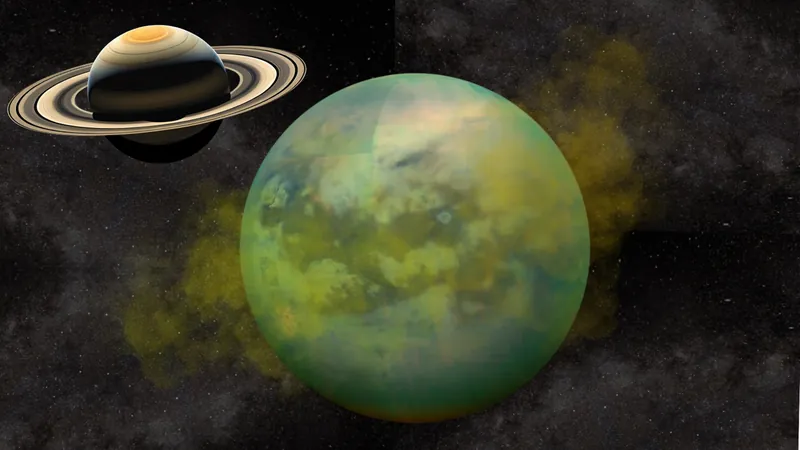
Could Titan, Saturn’s Mysterious Moon, Harbor Life Beneath a Thick Methane-Ice Shell?
2024-10-30
Author: Siti
Recent scientific breakthroughs have revealed tantalizing possibilities about Saturn's largest moon, Titan, suggesting it may be enveloped by a staggering six-mile-thick (9.7-kilometer-thick) crust of methane ice. This insulated layer might not only make it easier to detect potential signs of life from Titan's subsurface ocean but could also provide insights beneficial to combating climate change here on Earth.
While Titan is a moon, its characteristics are remarkably Earth-like, making it unique in the solar system. It boasts a dense atmosphere as well as lakes and rivers, all filled not with water, but with hydrocarbons like methane and ethane. Interestingly, beneath its icy exterior lies water, revealing that this moon is more dynamic than previously thought.
A dedicated team of planetary scientists from the University of Hawaii at Mānoa uncovered the potential existence of this methane ice layer, discovering that methane gas could be entrapped within Titan's icy shell. This gas could warm the underlying layers, helping molecules to rise to the surface and possibly displaying signs of life. "If life exists in Titan's ocean under the thick ice shell," remarks research team leader Lauren Schurmeier, "biomarkers would need to be transported up to where we could easily access them with future missions."
The team's exploration into Titan's landscape was partially sparked by the observation of shallow impact craters on its surface. Surprisingly, Titan exhibits only 90 impact craters, significantly fewer than other similar celestial bodies. The shallow nature of these craters puzzled scientists, as they were anticipated to be much deeper.
To investigate further, the researchers employed advanced computer modeling to simulate how the icy surface of Titan would react after asteroid impacts if covered in methane clathrate, a unique solid that encompasses methane within a crystalline water structure. Their simulations suggested that the insulating properties of this clathrate could explain the shallower craters, with predicted depths aligning closely with the observed data.
The findings point to a rich and dynamic atmosphere on Titan, which correlates with a significant methane cycle. Schurmeier explained how studying Titan offers crucial insights into the greenhouse gas methane and its behaviors—a direct analog to the destabilizing methane hydrates currently found on Earth, particularly in Siberian permafrost and beneath the Arctic Ocean floor. As permafrost thaws and releases methane, lessons learned from Titan could inform our understanding of similar processes occurring on our planet.
Ultimately, these revelations indicate that Titan may not merely be a cold and unyielding moon, but instead host a warm, active interior capable of facilitating chemical reactions possibly linked to life forms. For NASA, this research serves as an invaluable foundation as they prepare for the upcoming Dragonfly mission, set to launch in 2028. This innovative drone-like spacecraft will explore Titan's icy surface in detail, arriving in the Saturnian system by 2034.
The universe is replete with wonders, and Titan could very well be one of the most intriguing locales in the search for extraterrestrial life! Stay tuned for more exciting revelations as we delve deeper into the mysteries of our solar system!


 Brasil (PT)
Brasil (PT)
 Canada (EN)
Canada (EN)
 Chile (ES)
Chile (ES)
 Česko (CS)
Česko (CS)
 대한민국 (KO)
대한민국 (KO)
 España (ES)
España (ES)
 France (FR)
France (FR)
 Hong Kong (EN)
Hong Kong (EN)
 Italia (IT)
Italia (IT)
 日本 (JA)
日本 (JA)
 Magyarország (HU)
Magyarország (HU)
 Norge (NO)
Norge (NO)
 Polska (PL)
Polska (PL)
 Schweiz (DE)
Schweiz (DE)
 Singapore (EN)
Singapore (EN)
 Sverige (SV)
Sverige (SV)
 Suomi (FI)
Suomi (FI)
 Türkiye (TR)
Türkiye (TR)
 الإمارات العربية المتحدة (AR)
الإمارات العربية المتحدة (AR)